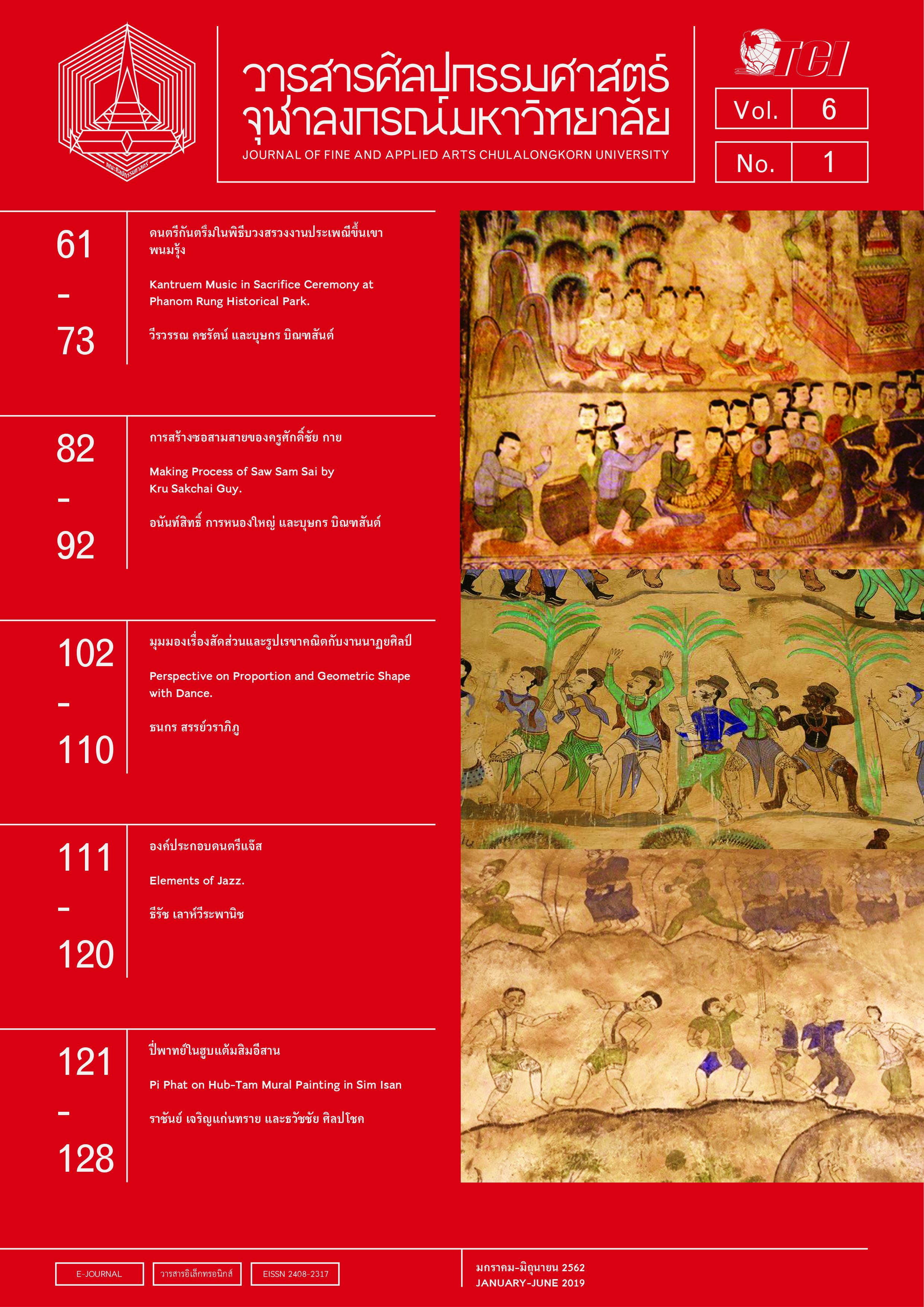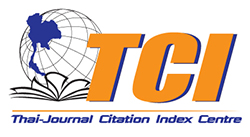วิเคราะห์ทางขับร้องเพลงหน้าพาทย์บทคอนเสิร์ต ตับนางลอย บ้านพาทยโกศล โดยครูอุษา แสงไพโรจน์
Keywords:
การขับร้อง, บทคอนเสิร์ต, ตับนางลอย, บ้านพาทยโกศล, อุษา แสงไพโรจน์, เจริญ พาทยโกศล, Vocal melodies, Suite, Tap Nang Loi, Ban Pattayakosol, Usa Sangphairogana, Charoen PattayakosolAbstract
บทคัดย่อ
งานวิจัยเรื่อง วิเคราะห์ทางขับร้องเพลงละครและหน้าพาทย์บทคอนเสิร์ต ตับนางลอย บ้านพาทยโกศล โดยครูอุษา แสงไพโรจน์ งานวิจัยเรื่อง วิเคราะห์ทางขับร้องเพลงละครและหน้าพาทย์บทคอนเสิร์ต ตับนางลอย บ้านพาทยโกศล โดยครูอุษา แสงไพโรจน์ มีวัตถุประสงค์เพื่อศึกษามูลบทที่เกี่ยวข้องและวิธีการขับร้องเพลง ผู้วิจัยได้ทำการเลือกศึกษาเพลงจำนวน 8 เพลง ได้แก่ เพลงโอ้ชาตรี เพลงโอ้โลมใน เพลงโอ้ปี่ใน เพลงช้าปี่ใน เพลงโลมนอก เพลงโล้ เพลงเชิดฉิ่ง และเพลงเชิดนอก ซึ่งผลการศึกษาสามารถสรุปได้ ดังนี้ ทางขับร้องเพลงบทคอนเสิร์ตตับนางลอยมีต้นกำเนิดมาตั้งแต่สมัยรัชกาลที่ 5 โดย นางเจริญ พาทยโกศล เป็นผู้ขับร้องคนแรกและเป็นผู้ถ่ายทอดวิธีการขับร้องให้คุณหญิงไพฑูรย์ กิตติวรรณ และครูอุษา แสงไพโรจน์ ผู้รับช่วงวิธีการขับร้องเป็นรุ่นที่ 3 จากการศึกษาทางขับร้องทั้ง 8 เพลง พบว่า ทุกเพลงใช้กลุ่มเสียงทางเพียงออล่างเป็นหลัก มีการกำกับจังหวะที่สามารถแบ่งออกได้เป็น 2 แบบ คือ การกำกับเพลงที่มีจังหวะควบคุมและการกำกับเพลงที่มีจังหวะลอย พบสังคีตลักษณ์ที่สามารถแบ่งได้เป็น 3 แบบ คือ การขับร้องที่มีดนตรีรับ การขับร้องที่มีดนตรีแทรกกลางคำร้อง และการขับร้องพร้อมกับการบรรเลงดนตรี วิธีการขับร้องที่ถือเป็นเอกลักษณ์ คือ การขับร้องแบบไม่ปั้นคำ เป็นการออกเสียงพยางค์เดี่ยวแบบตรงเสียงไม่มีการปรุงแต่งเสียง และพบกลวิธีการขับร้องทั้งหมด 10 กลวิธี คือ การครั่นเสียง การปั้นคำ การกระทบเสียง การผันเสียงลง การผันเสียงขึ้น การใช้หางเสียง การตวัดเสียง การกดเสียง การเหินเสียง และการกลึงเสียง กลวิธีที่ใช้มากที่สุดคือ การครั่นเสียง และกลวิธีการขับร้องที่มีเฉพาะเพลง คือ การกลึงเสียง ซึ่งพบในเพลงช้าปี่ในเท่านั้น ส่วนวิธีการขับร้องที่มีช่วงการเอื้อนเป็นทำนองโดยใช้ลมหายใจเดียว คือ เพลงเชิดนอก
Abstract
The study of A Musical Analysis of Phleng Lakhon and Phleng Naphat Vocal Melodies in Nang Loi Suite from Ban Pattayakosol by Kru Usa Sangphairogana aimed to study the related primes and the method of vocal melodies. The researcher selected 8 vocal melodies which consisted of Phleng Ochatree, Phleng Olomnai, Phleng Opinai, Phleng Chapinai, Phleng Lomnok, Phleng Lo, Phleng Choetching, and Phleng Choetnok. According to the study, it could be concluded that the origin of vocal melodies in Nang Loi Suite was in King Rama V Reign. Mrs. Charoen Pattayakosol was the first singer and transferred the techniques to Khunging Paitoon Kittiwan and Kru Usa Sangphairogana who were the 3rd generation. From the study of 8 vocal melodies, every melody used the sound group of Tang-Piang-or-Lang as the main. The rhythm conducting could be classified into 2 types which consisted of the conducting by the rhythm and Loy rhythm. Forms can be classified into 3 types which consist of the singing with the responded music, the signing with the inserted music among lyrics, and the singing with the music. The unique vocal melodies were the singing without the modification (Kan Pan Kham). Moreover, 10 vocal melody techniques are found which consisted of using of voice shaking (Kan Khran Siang), word modification (Kan Pan Kham), voice impact (Kan Kra Thop Siang), lower voice diversion (Kan Phan Siang Long), upper voice diversion (Kan Phan Siang Khun), tone of voice (Kan Chai Hang Siang), voice flicking (Kan Ta Wat Siang), voice compressing (Kan Kod Siang), voice raising (Kan Hoen Siang), and voice lathing (Kan Kolung Siang). The most famous technique was voice shaking (Kan Khran Siang). The technique which found particularly are voice lathing (Kan Kolung Siang) in only Phleng Chapinai. For the vocal melody which contained the drawing out the note as the melody with a single breath was Phleng Choetnok.
Downloads
Published
Issue
Section
License
ลิขสิทธิ์ของบทความเป็นของเจ้าของบทความ บทความที่ได้รับการตีพิมพ์ถือเป็นทัศนะของผู้เขียน
กองบรรณาธิการไม่จำเป็นต้องเห็นด้วยและไม่รับผิดชอบต่อบทความนั้น






